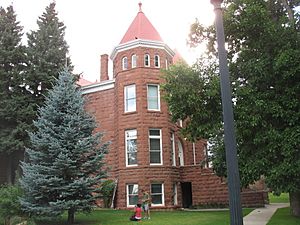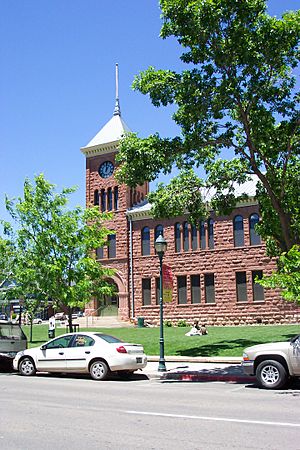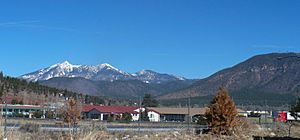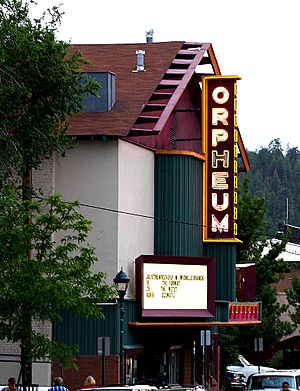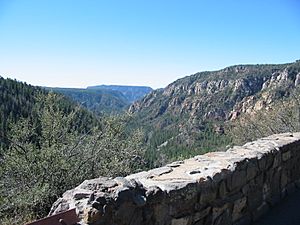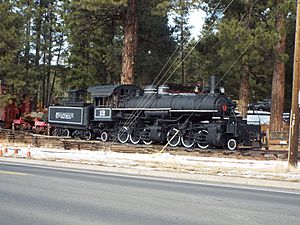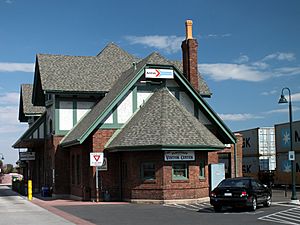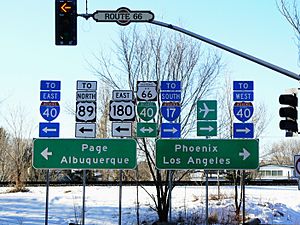Flagstaff, Arizona facts for kids
Quick facts for kids
Flagstaff, Arizona
|
|
|---|---|
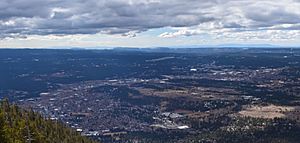
Flagstaff in 2019, as seen from Mount Elden
|
|
| Nicknames:
City of Seven Wonders, Dark Sky City
|
|
| Country | |
| State | |
| County | Coconino |
| Settled | 1876 |
| Incorporated | 1928 |
| Government | |
| • Type | Council–manager |
| • Body | Flagstaff City Council |
| Area | |
| • City | 66.08 sq mi (171.15 km2) |
| • Land | 66.03 sq mi (171.02 km2) |
| • Water | 0.05 sq mi (0.14 km2) |
| Elevation | 6,910 ft (2,106 m) |
| Population
(2020)
|
|
| • City | 76,831 |
| • Density | 1,163.59/sq mi (449.26/km2) |
| • Metro | 139,097 (US: 291st) |
| Demonym(s) | Flagstonian or Flagstaffer or Flagstaffian |
| Time zone | UTC−7 (MST (no DST)) |
| ZIP codes |
86001–86002, 86004–86005, 86011
|
| Area code(s) | 928 |
| FIPS code | 04-23620 |
| GNIS ID(s) | 28749, 29046 |
| Major airport | Flagstaff Pulliam Airport |
| Interstates | |
| U.S. Highways | |
| State Routes | |
Flagstaff ( FLAG-staf) is a city in, and the county seat of, Coconino County in northern Arizona, in the southwestern United States. In 2019, the city's estimated population was 75,038. Flagstaff's combined metropolitan area has an estimated population of 139,097.
Flagstaff lies near the southwestern edge of the Colorado Plateau and within the San Francisco volcanic field, along the western side of the largest contiguous ponderosa pine forest in the continental United States. The city sits at about 7,000 feet (2,100 m) and is next to Mount Elden, just south of the San Francisco Peaks, the highest mountain range in the state of Arizona. Humphreys Peak, the highest point in Arizona at 12,633 feet (3,851 m), is about 10 miles (16 km) north of Flagstaff in Kachina Peaks Wilderness. The geology of the Flagstaff area includes exposed rock from the Mesozoic and Paleozoic eras, with Moenkopi Formation red sandstone having once been quarried in the city; many of the historic downtown buildings were constructed with it. The Rio de Flag river runs through the city.
Originally settled by the pre-Columbian native Sinagua people, the area of Flagstaff has fertile land from volcanic ash after eruptions in the 11th century. It was first settled as the present-day city in 1876. Local businessmen lobbied for Route 66 to pass through the city, which it did, turning the local industry from lumber to tourism and developing downtown Flagstaff. In 1930, Pluto was discovered from Flagstaff. The city developed further through to the end of the 1960s, with various observatories also used to choose Moon landing sites for the Apollo missions. Through the 1970s and 1980s, downtown fell into disrepair, but was revitalized with a major cultural heritage project in the 1990s.
The city remains an important distribution hub for companies such as Nestlé Purina PetCare, and is home to the U.S. Naval Observatory Flagstaff Station, the United States Geological Survey Flagstaff Station, and Northern Arizona University. Flagstaff has a strong tourism sector, due to its proximity to Grand Canyon National Park, Oak Creek Canyon, the Arizona Snowbowl, Meteor Crater, and Historic Route 66.
Contents
History
There exists several stories and legends regarding the origin of the city's name. Surveyors, prospectors, and investors had traveled through the area in the mid- to late-19th century, and the act of stripping a pine tree to fly an American flag has been attributed to several individuals over the course of a twenty-year span. It is said that, because of the flag that was raised, the area surrounding it became known as Flagstaff.
The first permanent settlement was in 1876, when Thomas F. McMillan built a cabin at the base of Mars Hill on the west side of town. During the 1880s, Flagstaff began to grow, opening its first post office and attracting the railroad industry. The early economy was based on timber, sheep, and cattle. By 1886, Flagstaff was the largest city on the railroad line between Albuquerque and the west coast of the United States. A circa 1900 diary entry by journalist Sharlot Hall described the houses in the city at the time as a "third rate mining camp", with unkempt air and high prices of available goods.
In 1894, Massachusetts astronomer Percival Lowell hired A. E. Douglass to scout an ideal site for a new observatory. Douglass, impressed by Flagstaff's elevation, named it as an ideal location for the now famous Lowell Observatory, saying: "other things being equal, the higher we can get the better". Two years later, the specially designed 24-inch (610 mm) Clark telescope that Lowell had ordered was installed. In 1930, Pluto was discovered using one of the observatory's telescopes. In 1955 the U.S. Naval Observatory joined the growing astronomical presence, and established the United States Naval Observatory Flagstaff Station, where Pluto's satellite, Charon, was discovered in 1978.
During the Apollo program in the 1960s, the Clark Telescope was used to map the moon for the lunar expeditions, enabling the mission planners to choose a safe landing site for the lunar modules. In homage to the city's importance in the field of astronomy, asteroid 2118 Flagstaff is named for the city, and 6582 Flagsymphony for the Flagstaff Symphony Orchestra.
The Northern Arizona Normal School was established in 1899, renamed Northern Arizona University in 1966. Flagstaff's cultural history received a significant boost on April 11, 1899, when the Flagstaff Symphony made its concert debut at Babbitt's Opera House. The orchestra continues today as the Flagstaff Symphony Orchestra, with its primary venue at the Ardrey Auditorium on the campus of Northern Arizona University.
The city grew rapidly, primarily attributable to its location along the east–west transcontinental railroad line in the United States. In the 1880s, the railroads purchased land in the west from the federal government, which was then sold to individuals to help finance the railroad projects. By the 1890s, Flagstaff found itself located along one of the busiest railroad corridors in the U.S., with 80–100 trains travelling through the city every day, destined for Chicago, Los Angeles, and elsewhere.
Route 66 was completed in 1926 and ran through Flagstaff. Flagstaff was incorporated as a city in 1928, and in 1929, the city's first motel, the Motel Du Beau, was built at the intersection of Beaver Street and Phoenix Avenue. The Daily Sun described the motel as "a hotel with garages for the better class of motorists." The units originally rented for $2.60 to $5.00 each, with baths, toilets, double beds, carpets, and furniture. Flagstaff went on to become a popular tourist stop along Route 66, particularly due to its proximity to the Grand Canyon.
Flagstaff grew and prospered through the 1960s. During the 1970s and 1980s, however, many businesses started to move from the city center, and the downtown area entered an economic and social decline. Sears and J.C. Penney left the downtown area in 1979 to open up as anchor stores in the new Flagstaff Mall, joined in 1986 by Dillard's. By 1987, the Babbitt Brothers Trading Company, which had been a retail fixture in Flagstaff since 1891, had closed its doors at Aspen Avenue and San Francisco Street.
In 1987, the city drafted a new master plan, also known as the Growth Management Guide 2000, which would transform downtown Flagstaff from a shopping and trade center into a regional center for finance, office use, and government. The city built a new city hall, library, and the Coconino County Administrative Building in the downtown district, staking an investment by the local government for years to come. In 1992, the city hired a new manager, Dave Wilcox, who had previously worked at revitalizing the downtown areas of Beloit, Wisconsin and Missoula, Montana. During the 1990s, the downtown area underwent a revitalization, many of the city sidewalks were repaved with decorative brick facing, and a different mix of shops and restaurants opened up to take advantage of the area's historical appeal.
On October 24, 2001, Flagstaff was recognized by the International Dark-Sky Association as the world's first "International Dark-Sky City."
The Railroad Addition Historic District (Flagstaff, Arizona) was added to the National Register of Historic Places in 1983.
Geography
Flagstaff is located at 35°11′57″N 111°37′52″W / 35.19917°N 111.63111°W. According to the United States Census Bureau, the city has a total area of 63.9 square miles (165.5 km2), of which only 0.03 square miles (0.08 km2) (0.08%) is water.
At 7,000 feet (2,130 m) elevation, located adjacent to the largest contiguous Ponderosa Pine forest in North America, Flagstaff is located on a mountain surrounded by volcanoes, in the heart of the Coconino national forest. Any type of desert climate can be found below its elevation 100 miles from Flagstaff. The city is situated on the Rio de Flag, and is about 130 miles (210 km) north of Phoenix.
Cityscape
Downtown Flagstaff lies immediately to the east of Mars Hill, the location of Lowell Observatory. Streets in the downtown area are laid out in a grid pattern, parallel to Route 66 and the Burlington Northern Santa Fe Rail Line, running east–west through the city. Milton Road branches off from Route 66 west of downtown, and travels south, adjacent to the Northern Arizona University campus, to the junction of Interstate 17 and Interstate 40. Milton Road becomes I-17. A road called Beulah Boulevard, which also runs south, becomes State Route 89A, and travels through Oak Creek Canyon to Sedona. Traveling north from downtown, Fort Valley Road (U.S. 180) connects with the Museum of Northern Arizona, Arizona Snowbowl, and Grand Canyon National Park. Traveling east from downtown, Route 66 and the railroad run in parallel toward East Flagstaff (and beyond), at the base of Mount Elden. Much of Flagstaff's industry is located east of downtown, adjacent to the railroad tracks, as well as in East Flagstaff.
Several towns are located close to Flagstaff along Interstates 40 and 17. Approximately 6 miles (9.7 km) south are the small urban areas of Kachina Village (west of I-17) and Mountainaire (east of I-17; 2 miles (3.2 km)). About 35 miles (56 km) to the west is Williams, 20 miles (32 km) to the south is Munds Park, and 30 miles (48 km) to the south on Arizona Highway 89A is Sedona. 15 miles (24 km) to the east of Flagstaff is the town of Winona, mentioned in the famous song, Route 66.
Climate
Flagstaff has a rather dry semi-continental climate (Köppen Dsb/Csb). Flagstaff has five distinct seasons: a cold and snowy winter, with extended dry periods punctuated by deep snows about once every 3–4 weeks; a dry and windy spring with occasional snows; a very dry and hot early summer from May to early July; a wet and humid monsoon season from July to early September; and a dry and pleasant fall which lasts until the first snows in November.
The combination of high elevation and low humidity provide mild weather conditions throughout most of the year. The predominantly clear air and high elevation radiates daytime heating effectively resulting in overnight temperatures generally much lower than the daytime temperature. This means a 55 degree day in January can drop to 15 at night. Winter nights in fact can be extremely cold, with temperatures dropping below 0 °F (−17.8 °C) on 5 to 6 nights per year.
Winter weather patterns in Flagstaff are cyclonic and frontal in nature, originating in the eastern Pacific Ocean. These deliver periodic, widespread snowfall followed by extended periods of sunny weather. The area's generally stable weather pattern is broken by brief, but often intense, afternoon downpours and dramatic thunderstorms common during the monsoon of July and August. Summer temperatures are moderate and high temperatures average around 82 °F (27.8 °C). Extreme temperatures range from −30 °F (−34.4 °C) on January 22, 1937 up to 97 °F (36.1 °C) on July 5, 1973, respectively. The weather in Flagstaff is generally sunny, with much more sunshine than other snowy cities like New York City, Chicago, Boston and even Denver. Flagstaff is the only city in Arizona never to have reported temperatures of 100 °F (38 °C) or higher.
The annual snowfall averages 100.3 inches (254.76 cm), placing Flagstaff among the snowiest incorporated cities in the United States. Overall, the city features an average of 277 days without measurable precipitation each year. Despite snowstorms often being spread weeks apart, snow often covers the ground for weeks after major winter storms due to the low night temperatures refreezing the snowpack, even when daytime temperatures are above freezing. The maximum daily snow cover has been 83 inches (210.82 cm) on December 20, 1967, although the mean maximum for a full winter is only 20 inches (50.80 cm) and the lowest maximum only 6 inches (15.24 cm) in the dry winter of 1955–56. However, due to the infrequent and scattered nature of the snowstorms, persistent snow pack into spring is rare. One notable exception occurred during the severe winter of 1915–16, when successive Pacific storms buried the city under over 70 inches (177.80 cm) of snow, and some residents were snowbound in their homes for several days.
| Climate data for Flagstaff Pulliam Airport, Arizona (1981–2010 normals, extremes 1898–present) | |||||||||||||
|---|---|---|---|---|---|---|---|---|---|---|---|---|---|
| Month | Jan | Feb | Mar | Apr | May | Jun | Jul | Aug | Sep | Oct | Nov | Dec | Year |
| Record high °F (°C) | 66 (19) |
71 (22) |
73 (23) |
80 (27) |
89 (32) |
96 (36) |
97 (36) |
93 (34) |
91 (33) |
85 (29) |
74 (23) |
68 (20) |
97 (36) |
| Mean daily maximum °F (°C) | 42.5 (5.8) |
44.8 (7.1) |
50.4 (10.2) |
58.2 (14.6) |
68.1 (20.1) |
77.9 (25.5) |
81.2 (27.3) |
78.4 (25.8) |
72.9 (22.7) |
62.0 (16.7) |
50.5 (10.3) |
42.5 (5.8) |
60.8 (16.0) |
| Mean daily minimum °F (°C) | 17.3 (−8.2) |
19.3 (−7.1) |
23.6 (−4.7) |
28.5 (−1.9) |
35.0 (1.7) |
41.9 (5.5) |
50.9 (10.5) |
50.1 (10.1) |
42.0 (5.6) |
31.5 (−0.3) |
22.9 (−5.1) |
16.8 (−8.4) |
31.7 (−0.2) |
| Record low °F (°C) | −30 (−34) |
−23 (−31) |
−16 (−27) |
−2 (−19) |
7 (−14) |
22 (−6) |
32 (0) |
24 (−4) |
20 (−7) |
−2 (−19) |
−13 (−25) |
−23 (−31) |
−30 (−34) |
| Average precipitation inches (mm) | 2.05 (52) |
2.16 (55) |
2.12 (54) |
1.15 (29) |
0.63 (16) |
0.36 (9.1) |
2.61 (66) |
3.11 (79) |
2.38 (60) |
1.66 (42) |
1.76 (45) |
1.87 (47) |
21.86 (554.1) |
| Average snowfall inches (cm) | 23.2 (59) |
20.9 (53) |
20.7 (53) |
7.1 (18) |
0.7 (1.8) |
0 (0) |
0 (0) |
0 (0) |
trace | 1.5 (3.8) |
10.7 (27) |
16.9 (43) |
101.7 (258) |
| Average precipitation days (≥ 0.01 in) | 7.6 | 8.1 | 8.2 | 5.8 | 4.5 | 2.6 | 11.6 | 14.0 | 7.9 | 5.5 | 4.9 | 7.0 | 87.7 |
| Average snowy days (≥ 0.1 in) | 7.5 | 6.9 | 6.6 | 3.0 | 0.8 | 0 | 0 | 0 | 0 | 0.6 | 3.0 | 6.5 | 34.9 |
| Average relative humidity (%) | 61.9 | 59.5 | 54.9 | 46.5 | 39.4 | 33.6 | 51.1 | 58.1 | 54.7 | 52.6 | 56.9 | 60.6 | 52.5 |
| Mean monthly sunshine hours | 231.7 | 228.6 | 286.3 | 321.0 | 369.5 | 371.8 | 324.2 | 311.9 | 298.5 | 282.8 | 229.3 | 219.8 | 3,475.4 |
| Percent possible sunshine | 74 | 75 | 77 | 82 | 85 | 86 | 73 | 75 | 80 | 81 | 74 | 72 | 78 |
| Source: NOAA (relative humidity 1961–1990, sun 1973–1990) | |||||||||||||
Demographics
| Historical population | |||
|---|---|---|---|
| Census | Pop. | %± | |
| 1890 | 964 | — | |
| 1900 | 1,271 | 31.8% | |
| 1910 | 1,633 | 28.5% | |
| 1920 | 3,186 | 95.1% | |
| 1930 | 3,891 | 22.1% | |
| 1940 | 5,080 | 30.6% | |
| 1950 | 7,663 | 50.8% | |
| 1960 | 18,214 | 137.7% | |
| 1970 | 26,117 | 43.4% | |
| 1980 | 34,743 | 33.0% | |
| 1990 | 45,857 | 32.0% | |
| 2000 | 52,894 | 15.3% | |
| 2010 | 65,870 | 24.5% | |
| 2020 | 76,831 | 16.6% | |
| U.S. Decennial Census | |||
According to the 2010 census, the population of the city was 65,870. This accounted for a population density of 831.9 people per square mile (321.2/km²), with 26,254 housing units at an average density of 336.5 per square mile (129.9/km²). The racial makeup of the city was 73.4% White, 1.9% Black or African American, 11.7% Native American, 1.9% Asian, 0.2% Pacific Islander, 7.3% from other races, and 3.6% from two or more races; 18.4% of the population were Hispanics or Latinos of any race. The city's African American population is considerably lower than the U.S. average (1.9% versus 12.6%), while the Native American population is markedly higher (11.7% vs. 0.9%). This is primarily attributable to the city's proximity to several Native American reservations. Flagstaff's Native American community is chiefly Navajo, and there are about 5,500 people of Navajo ancestry living in the city.
A 1970 study found that while the Native American population of Flagstaff was generally under-counted in censuses, the Native residents found that Flagstaff as a border city with reservations was much more welcoming than similar towns, particularly noting Gallup, New Mexico as one that was worse. The study also documented that while there was a distinctly Native neighborhood in the poorer Southside area of Flagstaff, the housing quality varied greatly, with middle class Native residencies elsewhere in the city.
Though Flagstaff has a low African American population, it had seen large immigration of black people from the Southern United States in the middle of the 20th century during the Great Migration. Though most moved to California, there was a significant number that settled in Flagstaff after hearing that the lumber industry of northern Arizona was some of the best paid work going, and a familiar vocation for those from southern states.
Flagstaff has a well-educated population: as of 2018, over 90% of the population has a high school diploma or higher, and over 45% of the population has a bachelor's degree or higher; 100% of the Pacific Islander population in Flagstaff has a higher degree for a total of 30, with the lowest rate per race being 16.21% of the Native American population (at 554). The average earnings for people in Flagstaff is $36,536 p.a., rising to $55,258 for people with a graduate degree, with the low at $22,079 for people without a high school diploma.
Arts and culture
Flagstaff has an active cultural scene. The city is home to the Flagstaff Symphony Orchestra, which plays concerts from September through April at Ardrey Auditorium on the NAU campus. The city also attracts folk and contemporary acoustic musicians, and offers several annual music festivals during the summer months, such as the Flagstaff Friends of Traditional Music Festival, the Flagstaff Music Festival, and Pickin' in the Pines, a three-day bluegrass and acoustic music festival held at the Pine Mountain Amphitheater at Fort Tuthill Fairgrounds. Popular bands play throughout the year at the Orpheum Theater, and free concerts are held during the summer months at Heritage Square.
Flagstaff is home to an active theater scene, featuring several groups. Northern Arizona University Department of Theatre is an active and successful theatre program that produces quality productions for the community as well as the campus. The department has won many prestigious awards including multiple invitations to the Kennedy Center American College Theatre Festival. NAU Theatre performs in two facilities including the Clifford E. White Theatre (named for long-time Theatre professor Clifford E. White) and the Studio Theatre. Both facilities are housed in the Fine and Performing Arts Building on campus. The season includes 4 mainstage and numerous second stage productions and a summer collaboration with Theatrikos Theatre Company. Theatrikos Theatre Company, the community theater company, was founded in 1972 in the basement of the Weatherford Hotel, and today puts on five major productions per year. The group recently moved into a new venue in 2002, the Doris-Harper White Community Playhouse, a downtown building which was built in 1923 as an Elks Lodge and later became the Flagstaff library. Since 1995, the Flagstaff Light Opera Company has performed a variety of musical theatre and light opera productions throughout the year at the Sinagua High School auditorium. There are several dance companies in Flagstaff, including Coconino Community College Dance Program, Northern Arizona Preparatory Company and Canyon Movement, which present periodic concerts and collaborate with the Flagstaff Symphony for free concerts during the summer and holiday seasons.
A variety of weekend festivals occur throughout the year. The annual Northern Arizona Book Festival, held in the spring, brings together nationally known authors to read and display their works. The Flagstaff Mountain Film Festival is held every October, and features a variety of independent films and documentaries focusing on extreme sports, environmental issues, and global topics. The festival is four days long and consists of several sessions of films. The screenings are held at the Orpheum Theater in the historic downtown area. The summer months feature several festivals, including Hopi and Navajo Festivals of Arts and Crafts, the Arizona Highland Celtic Festival, Pride in the Pines, and the Made in the Shade Beer Tasting Festival. For more than 20 years Flagstaff has hosted the 10-day Flagstaff Festival of Science in September. It is a family event which features open houses, lectures, informal talks, and hands-on activities at area museums, observatories, other scientific facilities, and the university. In-school programs also are an important part of the festival. The festival begins with the annual Eugene Shoemaker keynote address. Guest speakers have included famous astronauts, arctic explorers, storm chasers, and scientists from many disciplines. The Coconino County Fair is held every September at the Fort Tuthill County Fairgrounds, featuring a demolition derby, livestock auction, carnival rides, and other activities.
On New Year's Eve, people gather around the Weatherford Hotel as a 70-pound, 6-foot (1.8 m) tall, metallic pine cone is dropped from the roof at midnight. The tradition originated in 1999, when Henry Taylor and Sam Green (owners of the Weatherford Hotel), decorated a garbage can with paint, lights, and pine cones, and dropped it from the roof of their building to mark the new millennium. By 2003 the event had become tradition, and the current metallic pine cone was designed and built by Frank Mayorga of Mayorga Welding in Flagstaff.
The Museum of Northern Arizona includes displays of the biology, archeology, photography, anthropology, and native art of the Colorado Plateau. The Arboretum at Flagstaff is a 200-acre (81 ha) arboretum featuring 2,500 species of drought-tolerant native plants representative of the high-desert region.
Route 66, which originally ran between Chicago and Los Angeles, greatly increased the accessibility to the area, and enhanced the culture and tourism in Flagstaff. Route 66 remains a historic route, passing through the city between Barstow, California, and Albuquerque, New Mexico. In early September, the city hosts an annual event, Route 66 Days, to highlight its connection to the famous highway.
Parks and outdoor recreation
Flagstaff has acquired a reputation as a magnet for outdoor enthusiasts, and the region's varied terrain, high elevation, and amenable weather attract campers, backpackers, climbers, recreation and elite runners, and mountain bikers from throughout the southwestern United States. There are 679.2 acres (274.9 ha) of city parks in Flagstaff, the largest of which are Thorpe Park and Buffalo Park. Wheeler Park, located adjacent to city hall, is the location of summer concerts and other events. The city maintains an extensive network of trails, the Flagstaff Urban Trails System, or "FUTS" includes more than 50 miles of paved and unpaved trails for hiking, running, and cycling. The trail network extends throughout the city and is widely used for both recreation and transportation.
The area is a recreational hub for road cycling and mountain biking clubs, organized triathlon events, and annual cross country ski races. Several major river running operators are headquartered in Flagstaff, and the city serves as a base for Grand Canyon and Colorado River expeditions.
Flagstaff's proximity to Grand Canyon National Park, about 75 miles (121 km) north of the city, has made it a popular tourist destination since the mid-19th century. Other nearby outdoor attractions include Walnut Canyon National Monument, Sunset Crater Volcano National Monument, Wupatki National Monument, and Barringer Crater. Glen Canyon National Recreation Area and Lake Powell are both about 135 mi (217 km) north along U.S. Route 89.
Sister cities
Flagstaff has five sister cities:
|
Economy
In its early days, the city's economic base comprised the lumber, railroad, and ranching industries. Today, that has largely been replaced by tourism, education, government, and transportation. Some of the larger employers in Flagstaff are Northern Arizona University, the Flagstaff Medical Center, and the Flagstaff Unified School District. Tourism is a large contributor to the economy, as the city receives over 5 million visitors per year.
Scientific and high tech research and development operations are in the city, including Lowell Observatory, Northern Arizona University, the United States Naval Observatory Flagstaff Station (NOFS) and the United States Geological Survey's (USGS) Flagstaff campus. Research is involved in observations of near-Earth phenomena such as asteroids and comets. In 2012 the observatory commissioned its Lowell Discovery Telescope, a 4.3-meter telescope with an instrument cube that can hold five instruments at once. Lowell Observatory and NOFS also are collaborators on the Navy Precision Optical Interferometer, on nearby Anderson Mesa. NOFS is heavily involved with the science of star catalogs and astrometry, or the positions and distances of stars and celestial objects.
There are five industrial parks in the city, situated near I-40 and I-17. Major manufacturers in Flagstaff include W. L. Gore & Associates, widely known as the maker of Gore-Tex; Nestlé Purina PetCare, manufacturer of pet food; SenesTech, a biotechnology research lab and manufacturer; SCA Tissue, a major tissue paper producer; and Joy Cone, manufacturer of ice cream cones. Walgreens operated a distribution center in the city until 2014.
Tourism
Flagstaff has a thriving tourism industry, and has since the early 1900s, primarily stemming from its proximity to the Grand Canyon National Park and other natural wonders, giving it the nickname 'City of Seven Wonders'. Other natural wonders and native ruins, Route 66, and its astronomical history also bring tourism from out of state, while people from further south in Arizona visit Flagstaff because of its cooler climate in the summer and its ski resort in the winter. The city has several hotels and restaurants, including its historic hotels. The first hotel of the Ramada Inn chain opened in 1954 at the intersection of Routes 66, 89, and 89A, adjacent to what was then Arizona State College (now NAU). The original building is still intact, operating as a Super 8 motel. Flagstaff is said to attract a lot of the tourism for the entire county as it is the only large population center that can cater to tourists, as well as being the location of information points for the National Park Service (NPS). In 1996, 39% of Coconino County residents were employed in tourism. There are large service sectors, particularly hotels and restaurants, in Flagstaff, with many of these companies having a close connection to NAU's School of Hotel and Restaurant Management, to employ these students.
Tourism to Flagstaff is a well-established industry, but still relies on environmental forces. Nature and weather conditions can damage tourism; having a mild but warm summer temperature attracts tourists from many locales, but storms and forest fires in its climate can be a detraction. Flagstaff also experiences very cold winters, and despite a successful ski resort still sees less tourism in this period; decreasing snow levels also threaten the winter industry. The pristine condition of the natural sites can also experience degradation due to overuse through tourism, losing its main selling point. The development of Tusayan into the Grand Canyon gateway town also affected Flagstaff's capture of some overnight tourists.
The Grand Canyon, a Wonder of the World, is about 80 miles (130 km) northwest of Flagstaff. The first stagecoach tours to the Grand Canyon from the city began running from the Bank Hotel in 1892. In 2000, about 5 million people visiting the Grand Canyon also visited Flagstaff. As Rick Heffernon wrote, "the world recognizes only one Grand Canyon, and northern Arizona has it". However, he also suggested this can act to the area's detriment, as the Grand Canyon is a world-class marvel and competes with other attractions of the same prestige for visitors, which are all equally impressive; Flagstaff itself also competes with its nearby towns for access to the Grand Canyon, several of which have growing themes based on it (like Tusayan and the Grand Canyon Village).
Lowell Observatory celebrated its 125th anniversary in 2019 and continues to be a leading astronomical research center, as well as a popular destination for visitors. More than 100,000 people visited in both 2018 and 2019; in 2019 the observatory opened its new Giovale Open Deck Observatory, an observation plaza with a suite of six advanced telescopes.
Arizona Snowbowl does not publish their revenue or make it public knowledge, which makes it hard to calculate its impact on the Flagstaff economy. The Snowbowl supports approximately 200 full-time jobs and $12.08 million in economic output for the city of Flagstaff.
Heffernon suggested that the perception of tourism from the residents of Flagstaff could affect the industry, something researched in 1990 by NAU's Tim Schroeder. Schroeder saw six main areas of concern from Flagstaff residents: "Standard of Living for Residents; Future Use of Parks; Quality of Fire Protection; Occurrences of Crime; Changes in Community Values, Norms and Customs; and Population Density". He acknowledged that the focus on fire protection was anomalous, and likely caused by a particularly high concern surrounding recent wildfires at the time the survey had been conducted. The respondents to Schroeder's survey generally found that their "Opportunity for Jobs, Opportunity for Shopping, Quality of Fire Protection, Understanding Different People, Quality of Health Care, Availability of Cultural Arts, and Overall Quality of Life" had improved because of tourism to the area, but that standards in terms of "Traffic and Road Conditions, General Prices for Goods and Services, Future Use of Forests, Noise, Litter, Air Quality, and Occurrences of Crime" had worsened.
Sports
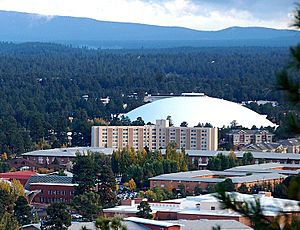
Flagstaff has no professional sports of its own, but is home to the college sports teams of Northern Arizona University. It is a popular training destination for a variety of sports, largely due to its altitude and climate.
Northern Arizona Lumberjacks
Northern Arizona University sponsors 15 sports at the NCAA Division I level, including a football team that competes at the Division I Football Championship Subdivision level. The NAU football team has a rivalry with the Southern Utah Thunderbirds, known as the Grand Canyon Rivalry, based on the universities residing on opposite sides of the Grand Canyon. All sports are members of the Big Sky Conference with the exception of the Women's Swimming & Diving team, which competes in the Western Athletic Conference. The Men's Cross Country team has featured four straight top ten finishes at the NCAA Division I Cross Country championships. The track and field team has been home to several All-Americans, including NCAA Champion and Olympian Lopez Lomong (and brother Peter Lomong), two-time NCAA Champion David McNeill, and 2012 Olympian Diego Estrada.
Arizona Cardinals
There are no major-league professional sports teams based in Flagstaff. However, from 1988 to 2012 (with the exception of the 2005 season), the Arizona Cardinals of the National Football League held their summer training camp at Northern Arizona University. The 2005 training camp relocated to Prescott because of a norovirus outbreak at the university that emerged from a summer wrestling training camp and infected over 100 people. The NAU training camp was named as one of the top five training camps in the NFL by Sports Illustrated, citing the cooler temperature, scenic area, and the possibility for fans to get close to athletes as key points. Players have said that the altitude of Flagstaff was the key benefit, as well as seeing the dedication of fans traveling to the city, but that they did not enjoy living in the NAU dorm rooms.
The Cardinals left Flagstaff in summer 2013, placing NAU at fault after the team was put in the visitors' facilities, though NAU had offered the home facilities when the concern was raised, and moved their training camp to State Farm Stadium in Glendale. At Glendale, they train in a domed stadium rather than outside, which player Bertrand Berry said took away some of the feeling of training camp, saying "there really isn't that need to practice outside when most of the games are inside, but when you talk about building a team and going through adverse situations and bonding together, I think they miss out on a little bit of that". The Cardinals had trained at NAU since the franchise moved to Arizona, with Fox Sports reporting that "some argued they pulled the plug on the team's only Arizona tradition". Bill Bidwill, owner of the Cardinals, was inducted into the Flagstaff Sports Foundation's Hall of Fame in 2009, after bringing the team and resultant tourism boost to the city for over 20 years.
Altitude training destination
Flagstaff is also a popular destination for altitude training. The first elite athletes to start altitude training in the city were those going to the 1968 Summer Olympics in Mexico City. A 2009 analysis showed that groups of 35 athletes spent three to eight weeks training in Flagstaff, to positive effect. This was one of the highest number of athletes and longest periods among seventeen sites used in the research. Australian rules football team Collingwood Magpies regularly train at NAU facilities, as does the Olympic-medal-winning Team GB British Swimming team. Another British Olympian, Mo Farah, trains in Flagstaff.
Long-distance runner Andrea Seccafien used to altitude train in Flagstaff but moved to Australia in 2018, saying "We don't go to Flagstaff or St. Moritz anymore which are more populated by runners and the general public. [...] Flagstaff feels quite metropolitan compared to where we are now"; the Canadian Running Magazine noted that the city becomes host to many professional runners in the spring. The popularity among runners is because of the altitude and pleasant climate, making it "for distance runners [...] a practically unparalleled paradise", known as the "running mecca". Runner Nick Hilton said that "Flagstaff and Boulder, Colorado, are probably the two biggest centers for elite distance runners in the country".
The HYPO2 altitude training center in the city is used by swimmers and runners alike, and is an elite facility that attracts many teams from around the world. HYPO2 was created in 2012, largely with staff from NAU's Center for High Altitude Training, which closed in 2009. As of 2019, over 85 Olympic medalists from 44 countries trained at the facility. In 2016, the city advertised NAU and the HYPO2 with promotions saying "The Road to Rio Runs Through Flagstaff", prominently noting that if Flagstaff (with its training athletes) was a country, it would be in the top 10 of Olympic-medal winning nations since 1996.
Education
There are 19 public schools, with 11,500 students and 800 faculty and staff, in the Flagstaff Unified School District. In 1997, Mount Elden Middle School was named an A+ School, citing an outstanding school climate, progressive use of technology and zero-tolerance approach to discipline. The 1999 National Science Teacher of the Year, David Thompson, teaches physics at Coconino High School. Three Arizona Teachers of the Year from 2001 through 2003 teach at Flagstaff High School. In 2012, Flagstaff was named America’s first STEM Community.
In addition to the numerous public schools, there are several charter schools operating in the Flagstaff area including Flagstaff Junior Academy, Northland Preparatory Academy (ranked No. 52 in US News's America's Top 100 Best High Schools), the Flagstaff Arts and Leadership Academy, Pine Forest Charter School, BASIS Flagstaff (ranked No. 2 in The Washington Post's America's Most Challenging High schools) and the Montessori Schools of Flagstaff.
Flagstaff is home to three institutions of higher education, Northern Arizona University (one of the three public state universities in Arizona); Coconino Community College; and Flagstaff College (a very small upper-division college with only one major – sustainability and social justice).
Infrastructure
Transportation
Road
The city is connected to Phoenix by Interstate 17 (I-17), and to Los Angeles, Las Vegas (via Route 93), and Albuquerque by Interstate 40 (I-40). Page can be reached via Route 89 from the city, as can Salt Lake City and, ultimately, Canada. The main road through Flagstaff is Route 66/Santa Fe Avenue, which runs parallel to the Burlington Northern Santa Fe (BNSF) Railway line east–west through the city. Downtown Flagstaff and the surrounding neighborhoods are separated from East Flagstaff by Buffalo Park, with the city connected by Route 66 and I-40. Route 66 is connected to the interstates in downtown by Milton Road, running roughly south alongside the NAU campus; Milton Road then merges into I-17. Flagstaff is connected to Sedona and Prescott by State Route 89A, which Beulah Boulevard merges into, and to the Grand Canyon by Route 180, which Fort Valley Road merges into just northwest of the city. It is the northern terminus of I-17 and Route 89A, and the southern terminus of Route 89.
Several towns are close to Flagstaff along I-40 and I-17. Approximately 6 miles (9.7 km) south are the small urban areas of Kachina Village (west of I-17) and Mountainaire (east of I-17; 2 miles (3.2 km)). About 35 miles (56 km) to the west is Williams, 20 miles (32 km) to the south is Munds Park, and 30 miles (48 km) to the south on Route 89A is Sedona. 15 miles (24 km) to the east of Flagstaff is the town of Winona.
From the city, Amtrak provides connecting Thruway Motorcoach service via Open Road Tours, which has an office inside the rail depot. Local bus service is provided throughout the city by the Mountain Line. Interstate bus service is provided by Greyhound Lines and Flixbus. Groome Transportation provides in-state shuttle service. Bus service to the Hopi Reservation is provided by Hopi Senom Transit, and to Tuba City and the Navajo Nation by Navajo Transit. Flagstaff is served by Navajo Transit Route 11 from Birdsprings to Tuba City.
Rail
The major rail corridor running through Flagstaff is the Southern Transcon, originally built by the Santa Fe Railroad and now owned and operated by the BNSF Railway. Passenger rail service is provided by Amtrak at the downtown Flagstaff station, connecting on east–west routes to Los Angeles and Albuquerque via the Southwest Chief line.
Air
Air travel is available through Flagstaff Pulliam Airport (IATA: FLG, ICAO: KFLG, FAA LID: FLG), just south of the city. The airport is primarily a small, general aviation airport with a single 6,999-foot (2,133 m) runway. The airport finished a major expansion project to add 1,800 feet (550 m) to the north end of the runway and lengthen the taxiway in 2007. The primary purpose of the project was to increase its viability for commercial and regional jets. Service to connecting flights at Phoenix Sky Harbor International Airport is provided by American Airlines operated by Mesa Airlines. As of January 2020 the airport offers year-round direct flights to Phoenix Sky Harbor International Airport, Dallas-Fort Worth International Airport, and Denver International Airport, on American Airlines and United Airlines.
Cycle
Flagstaff is fairly bike-friendly; there are bike lanes on many major streets, and the Flagstaff Urban Trails System (FUTS) includes more than 50 miles of off-street trails that wind throughout the community. In 2006 Flagstaff was designated a Bicycle-Friendly Community by the League of American Bicyclists. About nine percent of trips in Flagstaff are made by bicycle.
Utilities
Electricity generation in Flagstaff is provided by Arizona Public Service, an electric utility subsidiary operated by parent company Pinnacle West. The primary generating station near Flagstaff is the coal-fired, 995-MW Cholla Power Plant, near Holbrook, which uses coal from the McKinley Mine in New Mexico. Near Page is the coal-fired, 750-MW Navajo Power Plant, supplied by an electric railroad that delivers coal from a mine on the Navajo and Hopi reservations in northern Arizona. Flagstaff is also home to Arizona's first commercial solar power generating station, which was built in 1997 and provides 87 kW of electricity. Combined with 16 other solar power locations in Arizona, the system provides over 5 MW of electricity statewide.
Drinking water in Flagstaff is produced from conventional surface water treatment at the Lake Mary Water Treatment Plant, on Upper Lake Mary, as well as from springs at the inner basin of the San Francisco Peaks. Groundwater from several water wells throughout the city and surrounding area provide additional sources of drinking water. Water and wastewater services are provided by the City of Flagstaff.
Natural gas is provided by UniSource Energy Services. CenturyLink QC is the incumbent local exchange carrier. Cable television service is offered by Suddenlink Communications.
Notable people
Images for kids
-
Local rock strata monument in Heritage Square of downtown Flagstaff
See also
 In Spanish: Flagstaff para niños
In Spanish: Flagstaff para niños





